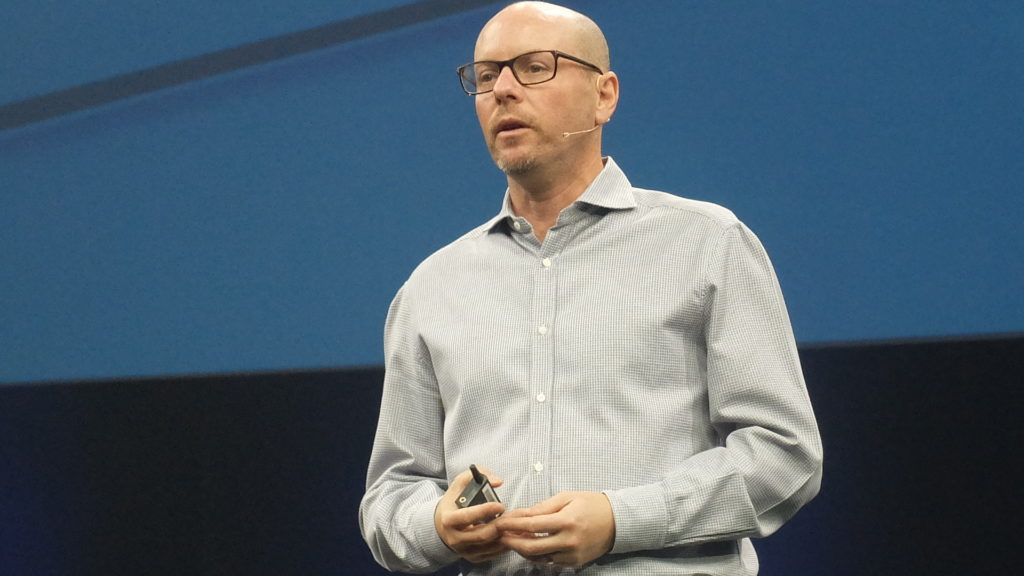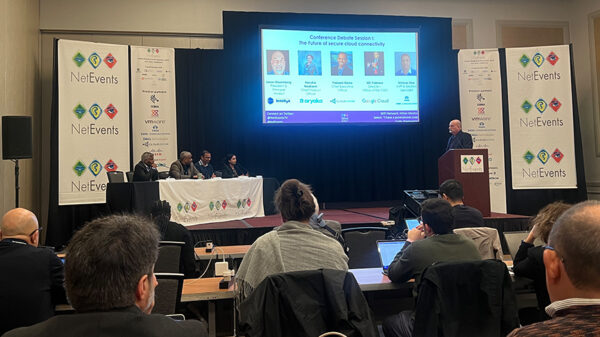SAN JOSE, Calif.—If there is one person that could give valuable advice to software startups that dream to be big one day, that would be Evan Goldberg, the man who founded NetSuite, Inc. after leaving Oracle Corp.
Goldberg, who is also the Chief Technology Officer of NetSuite, relates that his company has gone through the entire software company lifecycle: it started as a startup in 1998, became a mid-market company, grew to an up-market company, and in 2007 evolved to become a public enterprise that is set to hit the US$1 billion run rate this year. “I went through that failure mode which is sort of mandatory here in Silicon Valley; and then I started NetSuite as a result of what I learned,” shared Goldberg in his second keynote at this year’s Suiteworld Conference.
Establish that ‘North Star’
Goldberg said that the challenges are different in every single stage of the software company lifecycle. “Certainly, as a startup, you’ll worry about your early stage funding. You have an idea but how do you bring it to market. Also you need to know what the customers want. But stay focused on that North Star or where you want to be.”
Goldberg shared that when he started NetSuite, it was his former boss, Larry Ellison, who insisted that he start with an accounting system and focus on making sure that it is delivered over the internet so that companies don’t have to worry about managing complex software, database, and hardware. Ellison also emphasized on a built-in native web store.
A former startup company that helps startups
The NetSuite software has been a key driver in the company’s phenomenal growth. The company has used its own product, such as OneWorld, to help it go through all the stages of a software company lifecycle.
“So NetSuite is the only solution purpose-built for a software company; the only global cloud ERP; and the only solution that could scale with your growth. We have 5,000 employees logging into NetSuite everyday and our customers have similar levels of usage. Especially when you go into billing, there are some challenges there for internet companies that are delivering maybe a business-to-consumer service.”
Goldberg didn’t know anything about accounting, order management, and ERP when he started NetSuite, so he brought in people that understood them. “I only knew how to build an extensible application development platform, something I did in my whole career. So our vision is to help you achieve your business vision by being able to transform your systems in real-time as you transform.”
Today, NetSuite has 1,500 software industry company customers; more than 300,000 hours of industry business practices; more than 300 pre-built reports and dashboards; and 15 pre-defined roles. It is the No. 1 cloud ERP powering the software industry: from scale startups (eg. Daqri) to public companies (HP).
Throughout his keynote, Goldberg invited software companies that are in each stage of the lifecycle to share how NetSuite has helped them grow to the next level.
“We hope to show you today that NetSuite will be the first and last business system a tech company will ever need, and we want to show you what NetSuite can do for you across the entire lifecycle,” said Goldberg, noting that NetSuite has many features that can help a company in any stage of the software company lifecycle be compliant, become agile and grow to the next level. “Suitebilling, for example, provides you the flexibility to build your products anyway you want and invoice them any way you want.”
Stage 1: Smart startups establish a foundation to enable growth
“So our North Star was build a system to run a business, start with accounting, expand from there, and have a web store. So we established that North Star in the first five minutes of the company’s creation. And one of our points of success is we have been able to stay true to that. You have to bob and weave a little bit but you get there.”
For a startup to succeed and go to the next phase, Goldberg said it needs to:
- Secure funding. “I had that covered by Larry Ellison,” noted Goldberg.
- Prove the model. “No matter how challenging it is, keep an eye on that North Star.”
- Secure additional funding
- Prepare to scale. “You will never really know where your company is going. I didn’t know that when we started NetSuite, we would be helping the operations and giving visibility to very large public companies.”
- Give visibility for investors. “One of the best stories for me is when we announced our Executive Dashboard in 2001. Larry read about it in a press release which made him want to log into NetSuite. He had complete visibility into everything we were doing. So visibility into the past, present, and future is incredibly important.”
- Establish a system of record. “Typical startups may want to start up with QuickBooks. Software companies are the earliest to realize that they are going to scale rapidly and thus need a better system to manage the entire business.”
Stage 2: Winning in the mid-market
To talk about the mid-market, Goldberg invited the company’s Chief Financial Officer, Ron Gill, on stage. Gill, who worked with a startup before joining NetSuite, notes that winning in the mid-market requires agility, flexibility, and ability to scale. “We had all the challenges of operating a teeny, tiny company. We didn’t fail spectacularly, and we didn’t succeed spectacularly either. We were modestly successful.”
However, most of Gill’s career was spent at very large companies: Sony, SAP, and Dell. “I think along the way I decided there is a sweet spot somewhere in between this sort of steering the ocean-liner challenges of really huge companies. And the sweet spot really is the scaling of mid-size companies.”
When Gill joined NetSuite, the company was making the transition from being a software startup to becoming a mid-size company. Gill was key in helping NetSuite become an enterprise software company.
“We were preparing for an IPO; and it is really a tough transition to make because you’ve been a startup, especially a software startup. It has been all about innovation and flexibility at this point, and you’re going to have to start putting in place some repeatable process, controls, and all the things that you don’t like when you’re being that innovative startup. It’s a tough balance to strike.”
Thus, for mid-market companies to succeed, Gill said they need to:
- Go-to-market at scale
- Prepare for global expansion. “Local laws and taxes are just some of the challenges,” notes Gill.
- Secure additional funding
- Prepare for IPO or exit
- Offer visibility for investors and auditors
- Establish controls but remain agile. “Strike a balance between control and innovation.”
One of the companies that has also successfully transitioned from startup to mid-size company is DocuSign, a big user of NetSuite and vice versa.
Stage 3: Successful global expansion during the move up-market
As software companies grow beyond a mid-size company additional complexities emerge, says Gill, and they are:
- Business model innovation. “In the beginning it was all innovation but, at this point, you may need to recapture that agility in order to respond to competition,” said Gill.
- Global business at scale. “You will need a new model for deploying into multiple countries, and get consistent operational processes and controls; and most of all visibility.”
- Acquisitions fuel growth. “At this stage, a lot of companies are doing acquisitions to either get more innovation or get more growth.”
- Public company stewardship. “Whether you’re a late-stage private company with a large institutional money in, whether you’re private equity-owned, or you’re preparing for IPO, you are probably fundamentally running on a public company stewardship model. Compliance becomes critical when you grow and get an IPO.”
- New external stakeholders
- Maintain ability to pivot
An up-market company that uses NetSuite’s OneWorld is Genesys, a contact center software company that is private equity owned. It was already a fairly large organization when it deployed NetSuite, processing 25 billion interactions a year. “We chose NetSuite in 2012 and from then we have grown organically and through acquisition,” says Nick Gerastathos, the company’s SVP CAO and Interim CFO.

Google Director, Albert Belman: “We wanted a cloud-based ERP system to minimize the IT burden for all of the smaller startups.” PHOTO: MELBA BERNAD
Stage 4: Unlocking growth in the enterprise requires the agility of a startup
The final stage of the software company lifecycle is the public enterprise. “When you think about the North Star, you never actually reach it,” says Goldberg. “Yes, you’ve achieved your goal of being a billion dollar software company, but not many make it. It has incredibly been hard work but I’m as energized about the future of NetSuite as I’ve ever been.” One of the big challenges Goldberg faces now is how to preserve that great culture of innovation.
Goldberg says that for enterprises to be global and successful, they need to address the following issues:
- Business-wide innovation. “One of the big challenges that I see now is how to I preserve that culture of innovation. Really thinking about what is the engine of growth and again maintaining the focus on that North Star.”
- Unlock subsidiary growth. “At NetSuite, we have a lot of international subsidiaries. We sell a lot of related products.”
- M&A is the norm. “M&A is a part of growth. For us, acquisitions have been about acquiring great industry expertise, but how you bring them in the company is certainly an important part of that phase,” said Goldberg.
- Governance, risk and compliance. “For us it has really been a straight-forward transition into the public company world. But regulations change. There is a big focus on enterprise risks. So GRC is incredibly important.”
- Diverse external stakeholders. “Your external stakeholders will continue to diversify. You’re going to have a new set of investors and auditors. Being able to report to them is very important. Again, you’re going to have to give them great visibility.”
- Ability to move like a startup. “How do you preserve that energy, how do you preserve that innovation, how do you keep your people energized?”
A perfect example of a global enterprise company that is using NetSuite is Alphabet, Inc., the parent company of Google. Albert Belman, Google director, joined the company in 2015, just about the time Alphabet was announced.
“Alphabet’s idea is really to figure out how to continue with innovation and attract great entrepreneurs to Google while still maintaining the ability to collaborate with Google and having the size and scale,” said Belman. Today, there are 10 companies that are part of Alphabet and they range in size from a 20-person start-up called Sidewalk to Google Fiber.
Alphabet, or Google as it is commonly known, has gone through the entire software company lifecycle. Belman related that when they were looking for a system to help run Alphabet, they wanted a cloud-based ERP system to minimize the IT burden for all of the smaller startups. The company also wanted a system that would work across all the different domains it had. “There are very few companies that could work across all of those different verticals, and also work at the different stages of these companies.”
Belman revealed that NetSuite is today being used heavily by Nest and Calico, a bio-tech startup. “We are also in the process of recommending NetSuite to all of the other companies [under Alphabet.]”

Principal analyst, founder and chairman of of Constellation Research, Ray Wang: “Digital Darwinism is unkind to those who wait.” PHOTO: MELBA BERNAD
Biggest disruption
Just before he wrapped up his keynote, Goldberg invited an analyst on stage to give a different perspective of the software company lifecycle.
“We are in the middle of one of the biggest disruptions in the marketplace in software,” says Ray Wang, principal analyst, founder and chairman of of Constellation Research. “Almost every company wants to be a software company. So you have to figure out how to get through that lifecycle in all these different areas. As you go through each of these cycles, you are going to want a set of systems that would allow you to go through each of these areas, whether it is that growth phase, divestiture, M&A or the ability to spin-off new companies.
“Digital Darwinism is unkind to those who wait. There isn’t time. What we have to do in the software industry is to figure out how to balance those calls for margin and growth and the ability to scale and scale sustainably, and put all those together into one system in order to be successful.”






















































































































